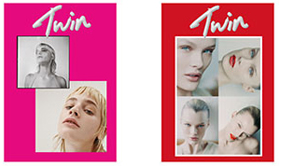Fashion and Fine Art are as intertwined as any two mediums can be, and so on the surface a project that brings together five artist and five designers doesn’t seem so radical. But not every designer is Raf Simons, able to access and afford the works of Sterling Ruby for his Dior collections, or Gianni Versace, making Warhol’s iconic work part of Versace’s iconic image without fear of being sued. A titan of one industry working with a powerhouse of another often produces incredible results, but it rarely exposes anyone to anything new.
The reality is that producing a collection or a piece of work takes time and money, and most emerging designers and artists are short on both. Encountering the work of someone new and having the infrastructure to collaborate is a privilege, and it is a privilege that the BFC Fashion Arts Foundations aim to extend to more makers. Now in its second year, the FAF’s Fashion arts Commissions scheme sees the British Fashion Council and the Royal Academy Schools pair NEWGEN designers with recent graduates of the RA Schools. Each pair is given a budget and mentoring, and a year to produce work to be exhibited and sold at Christie’s.
As you might imagine some pairs clicked immediately, finding a symbiosis between their practice that made them easy and natural collaborators – Liam Hodges and Nicky Carvell got on so well that they used part of their funding to take a research trip to LA together. For others the clash of influence, interest and expectation might have made the creative process a little more torturous, but this kind of friction is sometimes needed to provoke new ideas and ways of working. Eliza Bonham Carter, Head of the Royal Academy Schools, puts it best: ‘The value of this process lies not only in these bold, surprising and intriguing works of art, but also in the process by which they are achieved, which will inform the practice of each participant long into the future’.
In an era where arts funding is on its knees, and the government continues to cull art from school curriculums, it’s heartening to see organisations like the Fashion Arts Foundation are still around. All proceeds from the sale at Christie’s will go back in to the Foundation, to continue funding future cycles of collaboration. Unsurprisingly the final works are as strong and diverse as the participants. Encountering each other’s different mediums, approaches and frames of reference has produced a show that is a testament to the aims of the project – there is something new here. Across the hall from the more stiff traditional pieces that are the bread and butter of a house like Christie’s, the viewer suddenly encounters is a looming metal parasol, ominously askew and slick with fabric; distorted metal sculptures that feel like collages in motion; a carpet swatch rolodex of endlessly pleasing textures printed over with sinister undertones; a room of balance and tension shadowed by projection, and a series of playful, Zeuss-like structures that are as elegant as they are unusual.
Hear about each pair’s pleasingly divergent inspiration below:
LIAM HODGES & NICKY CARVELL
The ideas behind our work – industrialism, decay and rejuvenation sparked instantly on our first meeting. A shared search / destroy / rebuild attitude meant the work had to be uncompromisingly tough yet hopeful. A road trip to Los Angeles and to salvaged sites ‘Slab City’ and ‘Salvation Mountain’ were essential to instigate our shared visions. Process wise, Liam immediately wanted to set everything on fire. The nearest we came to this was welding scrap metal with sheet steel. The end results are robust sculptures made with the American ‘can do’ attitude brought to life in an East End warehouse.
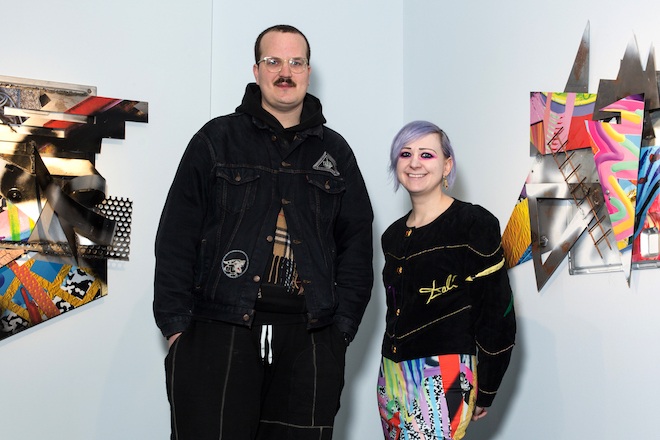
PAULA KNORR & APPAU JNR BOAKYE-YIADOM
We wanted to create a work that could exist in different iterations. Using materials that illustrated this, from the fabric that takes on different characteristics when hung, looking through, gathered on the floor or folded over. The parasol frame both electric and manually operated changing its size and orientation depending on the space in which its shown. The video illustrating a ball falling from the top of the frame to the bottom, looped in transit, accompanied with dubbed audio of a drum in an echo chamber of sound. Focusing on different forms of sculptural movement from both culture, fashion, video and sound.
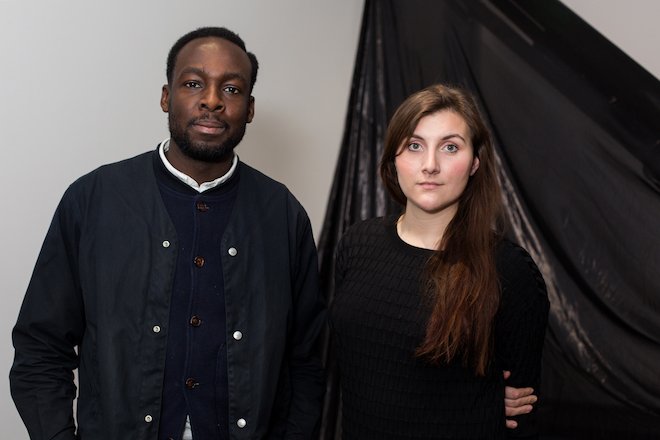
RICHARD MALONE & MARCO PALMIERI
A garment, as a term, is ambiguous; it can serve a limited but clear purpose, or on other occasions can shed its functional vestiges and slip into the realms of surrealism, play and sensuality. Our bodies share an intimate relationship with these fabrics and textiles, from the clothes we wear, to the furnishings that decorate our houses. At the same time this relationship is fragile and fleeting; fashion dictates a constant change in taste. Our hope with this collaboration was to create something tactile and ephemeral, like the clothes we inhabit for the recital of our daily routines – delicate skins we shed with seasonal regularity. From gentle poses of the hand that are sketched out on sheets of paper and lines of laser-cut aluminium, to oversized figures/mannequins robed in intricately patterned fabric, the pieces present themselves in a theatrical, surrealist spirit.
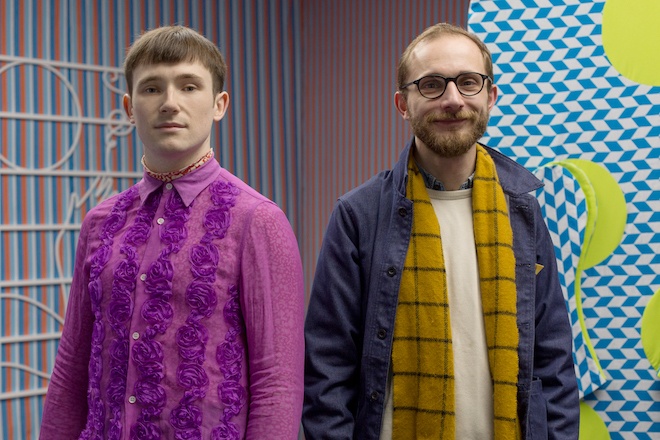
SADIE WILLIAMS & CARLA BUSUTTIL
In highlighting the politics of algorithmic era information commodification, we use Google Adwords as material for exploring consumer hierarchies. Our “Google Adword Library” contains some of the most expensive words on auction: Mesothelioma. Lawyer. Blackjack. Cord Blood. Spread Betting. We re-channelled these words through the search engine, collaging image results on textiles through painting, bonding and printing. The installation includes a ‘tombola’ showroom display. The metallic structure stands as a confident, analogue representation of an abstract digital marketplace for words. The tombola also references ‘old school’ methods of enticing consumers – contrasted here with modern visual and digital methods of production.
SAMUEL ROSS OF A-COLD-WALL* & JULIE BORN SCHWARTZ
The starting point of the project was an exploration into the different layers that appear in Samuel’s designs. Working with the film media we wanted to play with the possibilities of light and transparency, like a collage of the different layers and structures of the clothes itself. The process was an ongoing back and forth inspiration: the musical score was made after some of the editing of the film, and the last film edit was made from the music’s compositions.
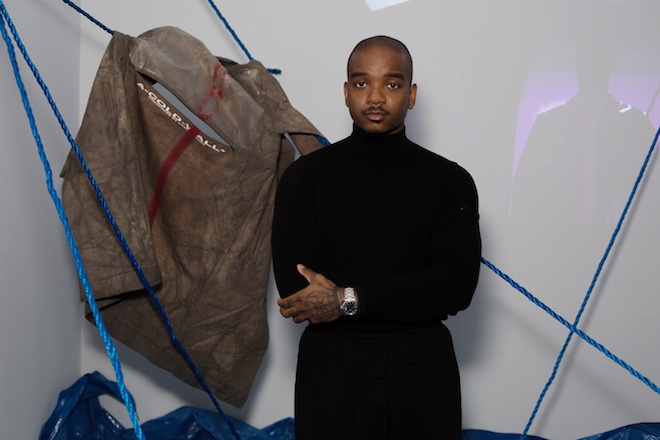
For sales enquiries contact the British Fashion Council.

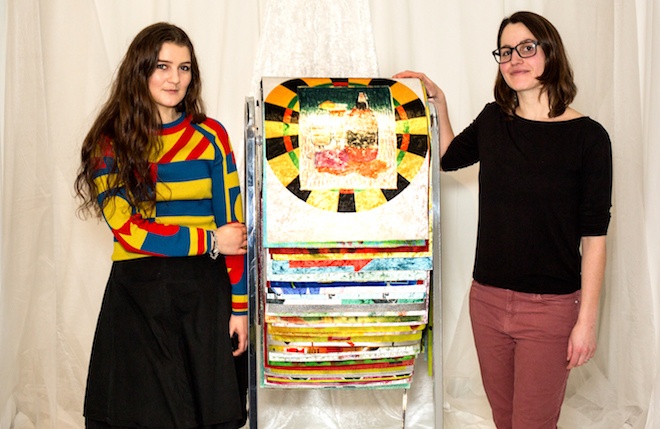
 PREVIOUS
PREVIOUS
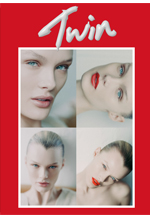
 Twitter
Twitter
 Tumblr
Tumblr
 YouTube
YouTube
 Facebook
Facebook
 Instagram
Instagram
